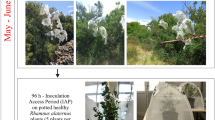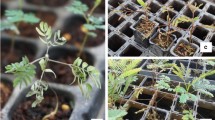Abstract
Colletotrichum spp. cause two important apple diseases, i.e., bitter rot (ABR) and Glomerella leaf spot (GLS). The present study aimed to compare the development of conidial anastomosis tubes (CATs) of strains of Colletotrichum spp. originating from ABR and GLS. For that, conidia were distributed on polystyrene slides and detached apple leaves surfaces, and the development of CATs and pre-infection structures, was microscopically examined. CATs connections were quantified and categorized into three types: conidium-conidium (c-c), conidium-germ tube (c-t) and germ tube-germ tube (t-t). CATs were observed in half of the strains, and Colletotrichum nymphaeae markedly produced more c-c connections at a higher speed. The t-t connections were less often observed in all strains. CATs were also frequently found in strains of Colletotrichum fructicola from fruits, but not in those from leaves, or in Colletotrichum theobromicola. Conidial germlings that produced CATs on polystyrene also did on leaves. Nuclear transference was observed in CATs. Appressoria melanization and CATs development were found to be antagonistic processes. The possible contribution of CATs and consequences for increasing variability of Colletotrichum on apple are discussed.




Similar content being viewed by others
References
Albuquerque, P., & Casadevall, A. (2012). Quorum sensing in fungi – a review. Medical Mycology, 50(4), 337–345.
Araújo, L., & Stadnik, M. J. (2013a). Cultivar-specific and ulvan-induced resistance of apple plants to Glomerella leaf spot are associated with enhanced activity of peroxidases. Acta Scientiarum, 35(3), 287–293.
Araújo, L., & Stadnik, M. J. (2013b). Múltiplos apressórios e tubos de anastomoses conidiais no processo infeccioso de Colletotrichum gloeosporioides em macieira. Bragantia, 72(2), 180–183.
Araújo, L., Gonçalves, A. E., & Stadnik, M. J. (2014). Ulvan effect on germination and appressoria formation of Colletotrichum gloeosporiodes. Phytoparasitica, 42(5), 631–640.
Calo, S., Billmyre, R. B., & Heitman, J. (2013). Generators of phenothypic diversity in the evolution of pathogenic microorganisms. PLoS Pathogens, 9(3), e1003181.
Cannon, P. F., Damm, U., Johnston, P. R., & Weir, B. S. (2012). Colletotrichum-current status and future directions. Studies in Mycology, 73(1), 181–213.
Gonçalves, A. E., & Stadnik, M. J. (2012). Interferência de ulvana na formação melanização de apressórios de Colletotrichum gloeosporioides. Tropical Plant Pathology, 37(6), 431–437.
González, E., Sutton, T. B., & Correll, J. C. (2006). Clarification of the etiology of Glomerella leaf spot and bitter rot of apple caused by Colletotrichum spp. based on morphology and genetic, molecular, and pathogenicity tests. Phytopathology, 96(9), 982–992.
Ishikawa, F. H., Souza, E. A., Read, N. D., & Roca, M. G. (2010). Live-cell imaging of conidial fusion in the bean pathogen. Colletotrichum lindemuthianum, Fungal Biology, 114(1), 2–9.
Ishikawa, F. H., Souza, E. A., Shoji, J. Y., Connolly, L., Freitag, M., Read, N. D., & Roca, M. G. (2012). Heterokaryon incompatibility is suppressed following conidial anastomosis tube fusion in a fungal plant pathogen. PloS One, 7(2), e31175.
James, S. W., Mirabito, P. M., Scacheri, P. C., & Morris, N. R. (1995). The Aspergillus nidulans bimE (blocked-in-mitosis) gene encodes multiple cell cycle functions involved in mitotic checkpoint control and mitosis. Journal of Cell Science, 108(11), 3485–3499.
Kershaw, M. J., & Talbot, N. J. (2009). Genome-wide functional analysis reveals that infection-associated fungal autophagy is necessary for rice blast disease. Proceedings of the National Academy of Sciences of the United States of America, 106(37), 15967–15972.
Latunde-Dada, A. O., O’Connell, R. J., Nash, C., & Lucas, J. A. (1999). Stomatal penetration of cowpea (Vigna unguiculata) leaves by a Colletotrichum species causing latent anthracnose. Plant Pathology, 48(6), 777–785.
Ludwig, N., Löhrer, M., Hempel, M., Mathea, S., Schliebner, I., Menezel, M., Kiesow, A., Schaffrath, U., Deising, H. B., & Horbach, F. (2014). Melanin is not required for turgor generation but enhances cell-wall rigidity in appressoria of the corn pathogen Colletotrichum graminicola. Molecular Plant-Microbe Interactions, 27(4), 315–327.
Mehrabi, R., Bahkali, A. H., Abd-Elsalam, K. A., Moslem, M., M’barek, S. B., Gohari, A. M., Jashni, M. K., Stergiopoulos, L., Kema, G. H. J., & Wit, P. J. G. M. (2011). Horizontal gene and chromosome transfer in plant pathogenic fungi affecting host range. FEMS Microbiology Review, 35(3), 542–554.
Nesher, I., Barhoom, S. & Sharon, A. 2008. Cell cycle and cell death are not necessary for appressorium formation and plant infection in the fungal plant pathogen Colletotrichum gloeosporioides. BMC Biology, (6)9, 1–11.
Pandey, A., Roca, M. G., Read, N. D., & Glass, N. L. (2004). Role of a mitogen-activated protein kinase pathway during conidial germination and hyphal fusion in Neurospora crassa. Eukaryotic Cell, 3(2), 348–358.
Pontecorvo, G. (1956). The parasexual cycle in fungi. Annual Review of Microbiology, 10(1), 393–400.
Read, N. D., Lichius, A., Shoji, J., & Goryachev, A. B. (2009). Self-signaling and self-fusion in filamentous fungi. Current Opinion in Microbiology, 12(6), 608–615.
Roca, M. G., Davide, L. C., Mendes-Costa & M. C. & Wheals, A. (2003). Conidial anastomosis tubes in Colleotrichum. Fungal Genetics and Biology, 40(2), 138–145.
Roca, M. G., Davide, L. C., Davide, L. M. C., Mendes-Costa, M. C., Schwan, R. F., & Wheals, A. E. (2004). Conidial anastomosis fusion between Colletotrichum species. Mycological Research, 108(11), 1320–1326.
Roca, M. G., Read, N. D., & Wheals, A. E. (2005). Conidial anastomosis tubes in filamentous fungi. FEMS Microbiology Letters, 249(2), 191–198.
Roca, M. G., Wheichert, M., Siegmund, U., Tudzynski, P., & Fleißner, A. (2012). Germling fusion via conidial anastomosis tubes in the grey mould Botrytis cinerea requires NADPH oxidase activity. Fungal Biology, 116(3), 379–387.
Ruiz-Roldán, M. C., Köhli, M., Roncero, M. I., Philippsen, P., Di Pietro, A., & Espeso, E. A. (2010). Nuclear dynamics during germination, conidiation, and hyphal fusion of Fusarium oxysporum. Eukaryotic Cell, 9(8), 1216–1224.
Takano, Y., Kikuchi, T., Kubo, Y., Hamer, J. E., Mise, K., & Furusawa, Y. (2000). The Colletotrichum lagenarium MAP kinase Gene CMK1 regulates diverse aspects of fungal pathogenesis. Molecular Plant-Microbe Interactions, 13(4), 374–383.
Velho, A. C., Alaniz, S., Casanova, L., Mondino, P., & Stadnik, M. J. (2015). New insights into the characterization of Colletotrichum species associated with apple diseases in Southern Brazil and Uruguay. Fungal Biology, 119(4), 229–244.
Wharton, P. S., & Diéguez-Uribeondo, J. (2004). The biology of Colletotrichum acutatum. Anales del Jardin Botánico de Madrid, 61(1), 3–22.
Zeigler, R. S., Scott, R. P., Leung, H., Bordeos, A. A., Kumar, J., & Nelson, R. J. (1997). Evidence of parasexual exchange of DNA in the rice blast fungus challenges its exclusive clonality. Phytopathology, 87(3), 284–294.
Acknowledgments
The authors thank the Brazilian Ministry of Education Agency for Graduate Studies (CAPES) for granting the M.Sc.-scholarship to the first author. M.J.S is a research member of the National Council for Scientific and Technological Development (CNPq). We are also grateful to Dr. M.B. de Freitas (UFSC) for critical reviewing of this manuscript.
Author information
Authors and Affiliations
Corresponding author
Rights and permissions
About this article
Cite this article
Gonçalves, A.E., Velho, A.C. & Stadnik, M.J. Formation of conidial anastomosis tubes and melanization of appressoria are antagonistic processes in Colletotrichum spp. from apple. Eur J Plant Pathol 146, 497–506 (2016). https://doi.org/10.1007/s10658-016-0934-6
Accepted:
Published:
Issue Date:
DOI: https://doi.org/10.1007/s10658-016-0934-6




